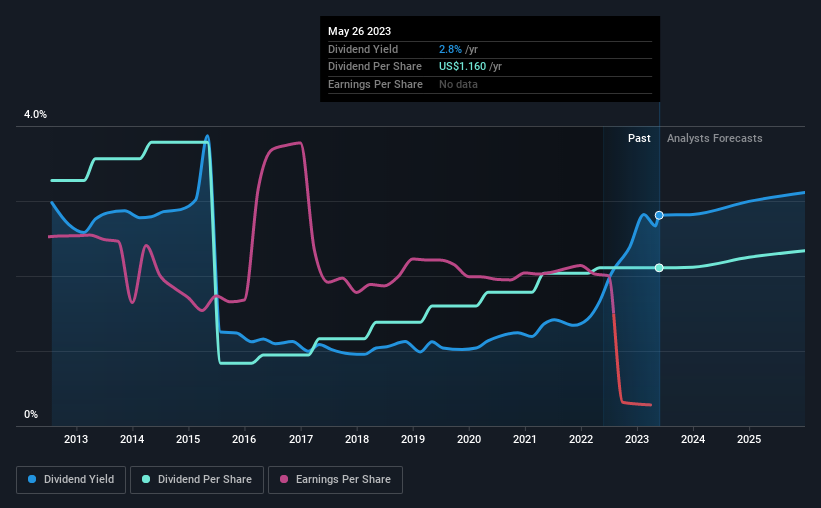Here's Why We're Wary Of Buying Baxter International's (NYSE:BAX) For Its Upcoming Dividend
Baxter International Inc. (NYSE:BAX) is about to trade ex-dividend in the next 4 days. The ex-dividend date is one business day before the record date, which is the cut-off date for shareholders to be present on the company's books to be eligible for a dividend payment. The ex-dividend date is important as the process of settlement involves two full business days. So if you miss that date, you would not show up on the company's books on the record date. Meaning, you will need to purchase Baxter International's shares before the 1st of June to receive the dividend, which will be paid on the 3rd of July.
The company's next dividend payment will be US$0.29 per share, and in the last 12 months, the company paid a total of US$1.16 per share. Last year's total dividend payments show that Baxter International has a trailing yield of 2.8% on the current share price of $41.29. If you buy this business for its dividend, you should have an idea of whether Baxter International's dividend is reliable and sustainable. We need to see whether the dividend is covered by earnings and if it's growing.
See our latest analysis for Baxter International
Dividends are typically paid out of company income, so if a company pays out more than it earned, its dividend is usually at a higher risk of being cut. Baxter International reported a loss after tax last year, which means it's paying a dividend despite being unprofitable. While this might be a one-off event, this is unlikely to be sustainable in the long term. Given that the company reported a loss last year, we now need to see if it generated enough free cash flow to fund the dividend. If Baxter International didn't generate enough cash to pay the dividend, then it must have either paid from cash in the bank or by borrowing money, neither of which is sustainable in the long term. Over the last year, it paid out more than three-quarters (75%) of its free cash flow generated, which is fairly high and may be starting to limit reinvestment in the business.
Click here to see the company's payout ratio, plus analyst estimates of its future dividends.
Have Earnings And Dividends Been Growing?
When earnings decline, dividend companies become much harder to analyse and own safely. If business enters a downturn and the dividend is cut, the company could see its value fall precipitously. Baxter International reported a loss last year, and the general trend suggests its earnings have also been declining in recent years, making us wonder if the dividend is at risk.
Another key way to measure a company's dividend prospects is by measuring its historical rate of dividend growth. Baxter International's dividend payments per share have declined at 4.3% per year on average over the past 10 years, which is uninspiring. It's never nice to see earnings and dividends falling, but at least management has cut the dividend rather than potentially risk the company's health in an attempt to maintain it.
Remember, you can always get a snapshot of Baxter International's financial health, by checking our visualisation of its financial health, here.
Final Takeaway
Should investors buy Baxter International for the upcoming dividend? First, it's not great to see the company paying a dividend despite being loss-making over the last year. On the plus side, the dividend was covered by free cash flow." Bottom line: Baxter International has some unfortunate characteristics that we think could lead to sub-optimal outcomes for dividend investors.
Having said that, if you're looking at this stock without much concern for the dividend, you should still be familiar of the risks involved with Baxter International. Every company has risks, and we've spotted 2 warning signs for Baxter International (of which 1 makes us a bit uncomfortable!) you should know about.
A common investing mistake is buying the first interesting stock you see. Here you can find a full list of high-yield dividend stocks.
Have feedback on this article? Concerned about the content? Get in touch with us directly. Alternatively, email editorial-team (at) simplywallst.com.
This article by Simply Wall St is general in nature. We provide commentary based on historical data and analyst forecasts only using an unbiased methodology and our articles are not intended to be financial advice. It does not constitute a recommendation to buy or sell any stock, and does not take account of your objectives, or your financial situation. We aim to bring you long-term focused analysis driven by fundamental data. Note that our analysis may not factor in the latest price-sensitive company announcements or qualitative material. Simply Wall St has no position in any stocks mentioned.
Join A Paid User Research Session
You’ll receive a US$30 Amazon Gift card for 1 hour of your time while helping us build better investing tools for the individual investors like yourself. Sign up here

 Yahoo Finance
Yahoo Finance 
